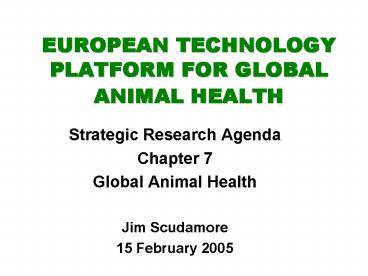EUROPEAN TECHNOLOGY PLATFORM FOR GLOBAL ANIMAL HEALTH - PowerPoint PPT Presentation
1 / 18
Title:
EUROPEAN TECHNOLOGY PLATFORM FOR GLOBAL ANIMAL HEALTH
Description:
Linkage to similar information in the EU would allow the development of synergy. ... Do you agree with the process which the Working groups have followed? ... – PowerPoint PPT presentation
Number of Views:51
Avg rating:3.0/5.0
Title: EUROPEAN TECHNOLOGY PLATFORM FOR GLOBAL ANIMAL HEALTH
1
EUROPEAN TECHNOLOGY PLATFORM FOR GLOBAL ANIMAL
HEALTH
- Strategic Research Agenda
- Chapter 7
- Global Animal Health
- Jim Scudamore
- 15 February 2005
2
Global Animal Health
- There is a global public good from helping the
world to address major animal diseases. Given the
importance of livestock to developing countries,
controlling and eradicating where practical
animal diseases will have direct and major
impacts on food security and poverty alleviation.
- Furthermore, the effective control of major
animal diseases will have a positive impact in
many areas of concern to society. All the
predictive trends indicate that the growth of
animal production systems will be located in the
developing world. - Due to intensification trends in animal
production systems in the developing countries
there will be more animal health problems and
diseases of intensification that will be
different from those found in Europe.
3
Global Animal Health
- The ETPGAH will take into account the
perspectives of the globalised setting in which
these diseases move. - There can be no question that combating diseases
at their source is the most efficient strategy. - The global nature of these problems and the scale
and complexity of new product development means
that solutions will not be very effectively
produced or very robust if developed exclusively
for and/or in Europe. - The scale and complexity of vaccine and
diagnostics development is such that alliances
with non-European countries and international
organisations such as the OIE and FAO will be
essential.
4
International Partnership with Developing
Countries
5
Benefits
- Research carried out in the countries of origin
of these diseases will provide valuable lessons
on the epidemiology and control measures for the
problem. - Many epizootic pathogens cannot legally be
introduced into Europe even for research
purposes. - Research such as field trials with vaccines and
/or diagnostic tests can be conducted in the
developing world, - Ethical issues must be taken in to account in
these circumstances when research is proposed in
developing countries which would not be permitted
in Europe.
6
Benefits
- A partnership is essential to improve the
technology and scientific capabilities of the
developing countries for controlling animal
diseases. - The ETPGAH will help to develop appropriate
technologies and tools for application at the
source of many disease problems where the
practices, incentives and infrastructure may be
less than optimal
7
Opportunities
- There is an appreciable amount of local expertise
on animal diseases in the developing countries.
For many diseases this is needed to complement
the work in Europe.
8
Opportunities
- Research infrastructures exist in the developing
countries including experimental facilities in
the national and institutional laboratories.
Industry support for the use of such facilities
should be encouraged. There is a need to map the
infrastructure, facilities and activities to
better understand the resources available to the
partnership. Linkage to similar information in
the EU would allow the development of synergy.
9
Opportunities
- Diseases which do not exist in Europe provide
unique appropriate models for - studying disease ecology and epidemiology
- studying host, vector, and pathogen biodiversity
- tropical diseases provide appropriate models for
understanding novel or emerging diseases
10
International Partnership Worldwide.
11
International Partnership Worldwide.
- Europe has difficulty in assembling enough
critical mass to apply comprehensive biology in
the veterinary field in a similar way to how it
is applied in the medical field. - Similarly, it is certainly true that there is
limited global capacity in Category 4 animal
accommodation and it makes sense to try to use
this strategically on a global basis rather that
each region pursue its own research programme
without consideration of avoiding duplication or
attempting to derive added value by working
together.
12
Chapter 7 Global Animal Health Recommendations
- 49. Introduce joint research programs with
institutes in non-EU countries, for important
diseases, which dont occur in the EU in order to
conduct risk analysis, undertake epidemiological
research, investigate outbreak scenarios and
evaluate intervention and control strategies.
(para 7.4.1)
13
Chapter 7 Global Animal Health Recommendations
- 50. Validate tools developed using modern
biotechnology to control animal diseases
representing a sanitary risk for Europe and other
countries in cooperation with the developing
countries. (para 7.4.2)
14
Chapter 7 Global Animal Health Recommendations
- 51. Promote the validation and marketing of
research products in third countries for a profit
shared with Europe.(para 7.4.3)
15
Chapter 7 Global Animal Health Recommendations
- 52. Provide sustainable support for research
through international cooperation in order to
improve knowledge and information for animal
diseases and zoonoses. (para 7.4.4)
16
Chapter 7 Global Animal Health Recommendations
- 53. Promote partnerships and provide finance for
joint research and development projects with
developing countries in order to assist with
capacity building by improving training,
infrastructure technical and scientific
capabilities for control of the diseases. (para
7.4.5)
17
Chapter 7 Global Animal Health Recommendations
- 54. Develop and fund collaborating centres
linking EU and developing country institutes.
(para 7.4.6)
18
Chapter 3Gap AnalysisConclusions
- Can you agree with the 5 areas for the gap
analysis? - Do you agree with the process which the Working
groups have followed? - Do you agree with the 7 recommendations in this
chapter?































